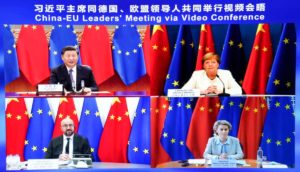In this paper, we study the concessional and non-concessional financial flows to developing countries provided by China, India and Russia under bilateral, triangular and multilateral formats, as well as trends for the coming years.
Beijing, New Delhi and Moscow have been offering three distinct models of aid allocation, which we describe as the Chinese Model (BRI-leading donor), the Indian Model (active triangular cooperation donor) and the Russian Model (region-level aid-shaping donor).
For the fiscal year 2021, China and Russia are upper-middle-income economies and India is a lower-middle-income economy. They face several ecological, demographical and economic problems. Nevertheless, China and India, described by Western countries as “growing powers”, and Russia – a “regional power up to 2045 (2015 UK National Security Strategy)” “seeking to restore its great power status” (US National Security Strategy 2017), have chosen to be active foreign development aid (FDA) donors.
Official documents emanating from the three countries expose the FDA purpose as follows: “…to forge the new win-win partnership and build a community of destiny for humanity” (Chinese President Xi Jinping’s speech of 28 September 2015 at the United Nations), “to extend support to the national efforts of other developing countries” (Ministry of Finance of India, 2003), and “to achieve in the long term the UN recommended target of allocating at least 0.7% of GNP to ODA” (The Russian External Policy Concept, 2007). Concretely, the forms, the dominant sectors and the geographical repartition of aid lead us to distinguish the following common drivers for their FDA strategy: economic empowering, increasing geopolitical weight in the desired multipolar world order, in particular ensuring favorable votes in the UN General Assembly, positive image building, and restriction of the influence of the other regional competitors. On the global stage, FDA strategy gravitates around the donor’s national interest. For example, the US budget for FY2021 clearly and openly states that the International Development Finance Corporation and the vindicated reforms at the Multilateral Development Banks will complement and enhance US strategic interests in the developing world. The promotion of the national interest is documented also in the United Kingdom’s aid strategy for 2015 and in the revised Japan’s Official Development Assistance Charter of 2015.
China: “Going out and buy” policy and the Belt and Road Initiative (BRI) dominate the development assistance strategy of China. China’s FDA is characterized by its huge financial capacity and a drive to lead a new global financial architecture. The debt burden resulting from Chinese aid flows is critical: China’s loan commitments to the Latin American and Caribbean countries (LAC) for the 2005-2016 amounted to USD 141 billion, exceeding the aid flows received from the Inter-American Development Bank, the World Bank and the Development Bank of Latin America over the same period respectively. It is alarming that, between 2010 and 2020, LAC external debt almost doubled from USD 1,3 trillion to USD 2,4 trillion. Around 20 per cent of all African government debt, 35 % of the total debt of Kyrgyzstan and more than half of Tajikistan’s external debt is owed to China.
On the other hand, according to McKinsey’s 2019 data, 57% of China’s national debt is corporate debt, of which ~70% are state-owned enterprises. As a result, we anticipate that Beijing will solicit in the future the local and multilateral financial institutions more broadly for financing its BRI-related transnational projects.
India: At the same time as the BRI was launched in China, New Delhi’s annual foreign development assistance budget increased from USD 940 million in 2012 to USD 1.5-3 billion in 2014. Nevertheless, India is mindful of its limited funding potential: “It would be suicidal for the Government of India to match port for port and airport for airport with China” (MOF of India, 2018). The largest democracy in the world is also conscious of the importance of having allies in facing up to China’s rise. “Oscillating pivot state“, “swinging between East and West”, India is looking for different groupings to support its own interests, which explains why India has been focusing reinforcing its foreign development assistance under a triangular model. New Delhi signed a wide range of agreements with traditional ODA donors, including the “India–US Statement of Guiding Principles on Triangular Cooperation for Global Development” with the US, the “Asia Connectivity Policy” and “India-EU Strategic Partnership: A Roadmap to 2025” with the EU, the “Statement of Intent on Partnership for Cooperation in Third Countries” with the UK, and the “Asia–Africa Growth Corridor” with Japan…
Russia: FDA was an important political instrument during the Soviet period: already in 1960, Soviet FDA was on par with US aid contribution as a % of GDP. After the collapse of the USSR, its successor, the Russian Federation, took time before returning to the international development assistance landscape as an important player, after testing its political allies formed during 1990s. Moscow’s international development assistance more than tripled between 2010 and 2015, from USD 520.9 million to USD1.7 billion.
Today, as a result of international sanctions, Russia is limited in its power to act according to its own rules. Moscow understands that “FDA is not charity for the sake of charity, but pragmatic method of realization of national interests” (Russian government, 2014). Despite Moscow’s “inherited mentality of a superpower”, Russia remains a modest player compared to China and USA in terms of FDA. “Russia’s ability to legislate the FDA “fashion” is still limited”, deplored the former head of Rossotrudnichestvo. To remedy this situation, Moscow is developing cooperation at the regional level. In 2019, the first “Russia-Africa Summit” and “Russia-Latin America and Caribbean Summit” took place where all parties involved declared their intention to develop cooperation on mutually beneficial condition. “Russia is composing herself”.
Moscow, Beijing and New Delhi recently united their voices in the field of FDA: at the 16th Meeting of the Foreign Ministers of the three countries in 2019, Ministers reaffirmed their commitment to the implementation of the Sustainable Development Goals and urged developed countries to honor their FDA commitments in accordance with the Addis Ababa Action Agenda.
Despite the trilateral and bilateral cooperation in the field of FDA, the trio sees a competitor in each other. Competition for influence is intense everywhere their interests collide: in particular in the Central Asia region, where a Russian footprint is important; in South and Southeast Asia that are a “kind of hybrid geo-cultural spaces equally susceptible to both Indian and Chinese influences”, but also in Africa and in Latin America. Meanwhile, competition is accentuated by the active FDA measures undertaken by other regional players, such as Japan and South Korea.
In conclusion, Foreign Development Assistance should be seen first and foremost as an instrument for assuring long-term economic security and geopolitical influence. In order to understand the impact of those three countries’ FDA strategies, a holistic approach must be adopted. FDA strategy must be studied alongside with other political and economic leverages such as diplomacy (hard as well as soft) and foreign economic relations.
Via this approach, the votes of the aid recipient countries at the UN General Assemblies can be explained on issues such as Crimea, North Korea’s human rights record, or opposition to the US veto on judicial appointments at the Appellate Body of the World Trade Organization, for example.
The full report can be downloaded here:
Picture credits: jasondavies.com World Cloud Generator




Be First to Comment